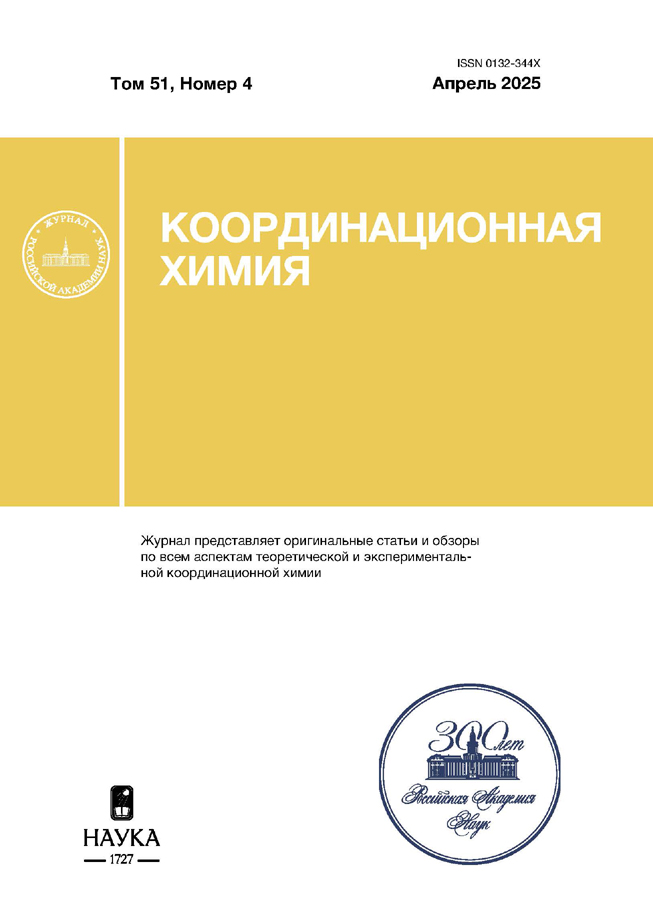Manganese(II) complexes based on sterically hindered {N,O,O} tridentate Schiff bases: synthesis, structures, and properties
- Авторлар: Garnovskii D.A.1, Vlasenko V.G.2, Lyssenko K.A.3, Knyazev P.A.2, Burlov A.S.2, Koshchienko Y.V.2, Uraev A.I.2, Levchenkov S.I.1, Ivakhnenko E.P.2
-
Мекемелер:
- Southern Scientific Center, Russian Academy of Sciences
- Southern Federal University
- Moscow State University
- Шығарылым: Том 51, № 4 (2025)
- Беттер: 211-221
- Бөлім: Articles
- URL: https://cardiosomatics.ru/0132-344X/article/view/679426
- DOI: https://doi.org/10.31857/S0132344X25040012
- EDN: https://elibrary.ru/LPNLBV
- ID: 679426
Дәйексөз келтіру
Аннотация
Manganese(II) complexes (DMSO){(DMSO)2bis[5,7-di-tert-butyl-2-(2-hydroxyphenolato)-1,3-benzoxazol-4-ol]}manganese(II) (Ia) and (DMSO)2{bis[5,7-di-tert-butyl-2-(2-hydroxyphenolato)-5-nitro-1,3-benzoxazol-4-ol]}manganese(II) (Ib) are synthesized from the tridentate sterically hindered Schiff bases: condensation products of 4,6-di-tert-butyl-2-aminophenol with salicylaldehyde derivatives N-(3,5-di-tert-butyl-2-oxyphenyl)salicylaldimine and N-(3,5-di-tert-butyl-2-oxyphenyl-5-nitro)salicylaldimine. The structures and compositions of the synthesized metal chelates are characterized by C, H, and N elemental analysis, IR spectroscopy, and magnetochemical measurement data. The EPR data in DMF and toluene are presented for complex Ia. The molecular structures of complexes Ia and Ib are proved by X-ray diffraction (XRD) results (CIF files CCDC nos. 2325776 (Ia) and 2325777 (Ib), respectively). In both complexes, the manganese ion exists in the octahedral {N2O4} ligand environment in which the coordination occurs due to two nitrogen atoms of the benzoxazole cycle and two oxygen atoms of the o-hydroxyphenol group and the apical positions are occupied by the oxygen atoms of two DMSO molecules.
Негізгі сөздер
Толық мәтін
Авторлар туралы
D. Garnovskii
Southern Scientific Center, Russian Academy of Sciences
Хат алмасуға жауапты Автор.
Email: ayueliseeva@mail.ru
Ресей, Rostov-on-Don
V. Vlasenko
Southern Federal University
Email: ayueliseeva@mail.ru
Research Institute of Physics
Ресей, Rostov-on-DonK. Lyssenko
Moscow State University
Email: ayueliseeva@mail.ru
Ресей, Moscow
P. Knyazev
Southern Federal University
Email: ayueliseeva@mail.ru
Research Institute of Physical and Organic Chemistry
Ресей, Rostov-on-DonA. Burlov
Southern Federal University
Email: ayueliseeva@mail.ru
Research Institute of Physical and Organic Chemistry
Ресей, Rostov-on-DonYu. Koshchienko
Southern Federal University
Email: ayueliseeva@mail.ru
Research Institute of Physical and Organic Chemistry
Ресей, Rostov-on-DonA. Uraev
Southern Federal University
Email: ayueliseeva@mail.ru
Research Institute of Physical and Organic Chemistry
Ресей, Rostov-on-DonS. Levchenkov
Southern Scientific Center, Russian Academy of Sciences
Email: ayueliseeva@mail.ru
Ресей, Rostov-on-Don
E. Ivakhnenko
Southern Federal University
Email: ayueliseeva@mail.ru
Research Institute of Physical and Organic Chemistry
Ресей, Rostov-on-DonӘдебиет тізімі
- Hoskins B.F., Robson R., Williams G.A. et al. // Inorg. Chem. 1991. V. 50. № 22. P. 4160. https://doi.org/10.1021/ic00022a015
- Shmakova T.O., Garnovskii D.A., Lyssenko K.A. et al. // Russ. J. Coord. Chem. 2009. V. 35. N 9. P. 657. https://doi.org/10.1134/S107032840909005X (Шмакова Т.О., Гарновский Д.А., Лысенко К.А, и др. // Коорд. химия 2009. Т. 35. № 9. С. 1).
- Shmakova T.O., Garnovskii D.A., Lyssenko K.A. et al. // Russ. Chem Bull. 2009. V. 58. № 7. P. 1383. https://doi.org/10.1007/s11172-009-0184-2 (Шмакова Т.О., Гарновский Д.А., Лысенко К.А. и др. // Изв. РАН. Сер. хим. 2009. № 7. С. 1344).
- Borisova A.O., Garnovskii D.A., Korshunova E.V. et al. // Russ. Chem Bull. 2012. V. 61. № 11. P. 2070. https://doi.org/10.1007/s11172-012-0289-x (Борисова О.А., Гарновский Д.А., Коршунова Е.В. и др. // Изв. АН. Сер. хим. 2012. № 11. P. 2053).
- Garza-Ortíz A., Martínez P.A., Duarte-Hernández A.M. et al. // J. Mol. Struct. 2013. V. 1032. P. 265. https://doi.org/10.016/j.molstruyct.2012.09.078
- Mukherjee S., Weyhermüller T., Böthe E. et al. // Eur. J. Inorg. Chem. 2003. № 5. P. 863. https://doi.org/10.1002/ejic.200200594
- Mukherjee S., Weyhermüller T., Bothe E. // Eur. J. Inorg. Chem. 2003. № 10. P. 1956. https://doi.org/
- VenkatRamani S., Chivinga I., Abboud K., Veige A.S. // Dalton Trans. 2015. V. 44. P. 18475. https://doi.org/10.1039/c5dt02911b
- Treqi X., Guang-Pen W., Jie L., Xiao-Bing L. // Inorg. Chem. 2011. V. 50. № 21. P. 10884. https://doi.org/10.1021/ic.2014286
- Li A., Haiyan M., Juling H. // organometallics. 2013. V. 32. P. 7460. https://doi.org/10.1021/om4009636
- Schmidt A.-C., Hermsen M., Rominger F. et al. // Inorg. Chem. V. 56. № 3. P. 1319. https://doi.org/10.1021/acs.inorgchem. 6b02322
- Hongshan K., Yongheng Y., Wen W. et al. // Dalton Trans. 2020. V. 49. P. 10594. https://doi.org/10.1039/DODT02139
- Hongshan K., Wen W., Yongheng Y., et al. // Inorg. Chem. 2020. V. 59. Т 5. P. 2833. https://doi.org/10.1021/acs.inorgchem.9b03169
- Ou H.-W., Lu W.-Y., Vandavasi J.K. et al. // Polymer. 2018. 2018. V. 140. P. 315. https://doi.org/10.1016/j.polymer.201802.016
- Kochem A., Gellon G., Jarjais O. et al. // Dalton Trans. 2015. V. 44. P. 12743. https://doi.org/10.1039/c5dt00944h
- Abakumov G.A., Egorova E.N., Kucherova T.N. et al. // RSC Adv. 2014. V. 4. P. 14495. https://doi.org/10.1039/c3ra47669c
- Fujita O., Sugimoto H., Morimoto Y. et al. // Inorg. Chem. 2018. V. 57. № 5. P. 9738. https://doi.org/10.1021/ acs. inorgchem. 8b00289
- Balaghi S.E., Safaei E., Rafiee M. et al. // Polyhedron. 2012. V. 47. P. 94. https://doi.org/10.1016/j.poly.201207.096
- Ley K., Müller E. // Chem. Ber. 1956. V. 89. № 6. P. 1402.
- Bruker. ApexII. Madison (WI, USA): Bruker AXS Inc., 2008.
- Sheldrick G.M. SADABS. Germany (Göttingen): Univ. of Göttingen, 1997.
- Sheldrick G.M. // Acta Crystallogr. A. 2008. V. 64. P. 112. https://doi.org/
- Sheldrick G.M. // Acta Cryst. 2015. V. A71. P.3. doi: 10.1107/S2053273314026370.
- Ma Q., Zhu M., Feng S., Lu L. // Acta Crystallogr. E. 2010. V. 66. m523. https://doi.org/10.1107/S1600536810012894
- Vetrova E.V., Tupaeva I.O., Sayapin Y.A. et al. // Dyes and Pigments. 2020. V. 180 № 108417. https://doi.org/10.1016/j.dyepig.2020.108417
Қосымша файлдар

















